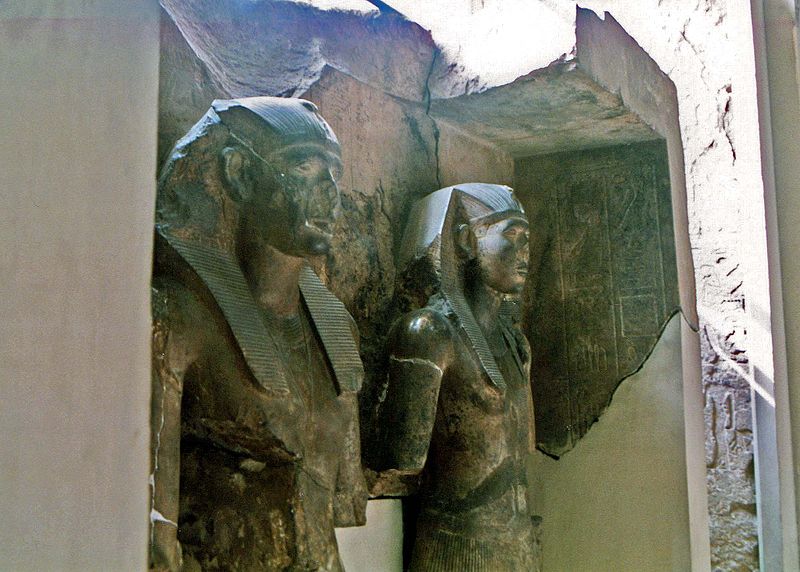
Bereishit יב (Genesis 12)
10 And there was a famine in the land; and Abram went down into Egypt to sojourn there; for the famine was sore in the land.
According to tradition there was a famine in the land of Canaan which forced Abram and Sarai to immigrate to Egypt. The year of this immigration – according Jewish tradition – was 1738 BCE.
This would place this immigration during the 13th Dynasty of Egypt (1786-1633 BCE). It was at this time the Egypt had already lost much of its power and the cohesion it once held. The Egyptian military that was stationed in Nubia became more independent and some even moved permanently to Nubia. The border with Nubia was abandoned or not thoroughly controlled and many of the fortresses on the border were abandoned. Due to the breakdown of the border, nomadic Canaanites freely entered Egypt. Many of these Canaanites settled in Egypt and became part of the economic and social fabric of Egypt. By the end of the 13th Dynasty the Eastern Delta was mostly populated by Asiatic peoples.1
The true chronology of the 13th dynasty is rather vague since there are few surviving monuments from this period. There were many kings who reigned for a short time, who were not of a single family and some were born commoners.2
The potential list of reigning pharaohs for this time period include:
Neferhotep I (Malek)
Neferhotep is listed as the 22nd king of the 13th Dynasty in the Abydos lists, and is assumed to have ruled for about ten years The Turin canon lists him as pharaoh 27 in the dynasty, with a length of rule of about 12 years. Even though he was not related to any existing royal family, his father’s position as a temple priest allowed him to gain the throne. His mother may have been a child or grandchild of Amenemhet III from the 12th Dynasty.
He left behind no monumnetal buildings, but the artifacts associated with Neferhotep are many — 60 or so scarab seals with his name, 2 cylinder seals, two setale (from the 2nd and 4th years of his reign), and three statues — one from Elephantine and two from the Tempe of Karnak in Thebes.3
Sobekhotep IV (Piccione)
Sobekhotep IV (another of the kings to honor the crocodile god Sobek in his name) was the younger brother of his true predecessor, Neferhotep I. It is possible that their claim on the throne, while enhanced by their father’s status as a high priest, was generally insured by their mother, who may have been a grandchild or great grandchild of the 12th Dynasty king Amenemhet III. This would have given them a strong hold on the throne of Egypt.
Sobekhotep IV was considered one of the most powerful of the 13th Dynasty kings. He secured the southern border and maintained control of the Nubian home and maintained the relatively peaceful status of the Egyptian kingdom.4
Sihathor
Sihathor was an official during the 12th Dynasty, serving Amenemhet II (1929-1892 B.C.) as a supervisor of Egyptian mines in the Sinai and in the region below the cataracts. He was considered an expert on turquoise, a stone prized by the Egyptians and favored by the goddes Hathor. He also took part in the construction of the pyramid of Amenemhet II at dashur, and supervised the building of ten statues for the mortuary complex. Sihathor’s stela, which gives an account of his career and his era, is in the British Museum.5
———————————–
1André Dollinger. “Dynasties XII to XVII: The growth of the middle class and the conquest of the Hyksos.” reshafim.org. Pharaonic Egypt. June 2010. Web. 15 April 2012. [http://www.reshafim.org.il/ad/egypt/history12-17.htm]
2“Ancient Egypt Kings and Queens.” eyelid.co.uk. Eyelid Productions. n.d. Web. 15 April 2012. [http://www.eyelid.co.uk/dynasty2.htm]
3“Neferhotep I.” phouka.com. Egyptian Journeys 2003, n.d. Web 21 September 2014. [http://www.phouka.com/pharaoh/pharaoh/dynasties/dyn13/13neferhotep1.html]
4“Sobekhotep IV.” phouka.com. Egyptian Journeys 2003, n.d. Web 21 September 2014. [http://www.phouka.com/pharaoh/pharaoh/dynasties/dyn13/14sobekhotep4.html]
5“Sihathor.” touregypt.net. Egypt Travel Guide, 20 June 2011. Web 21 September 2014. [http://www.touregypt.net/who/sihatho.htm]
